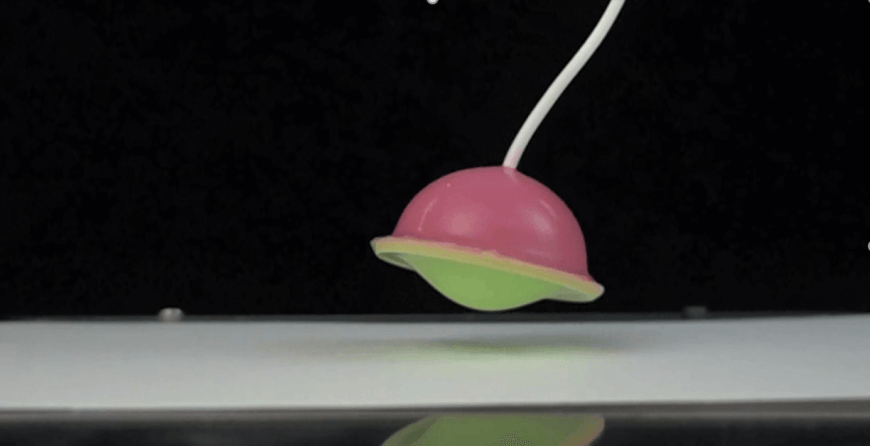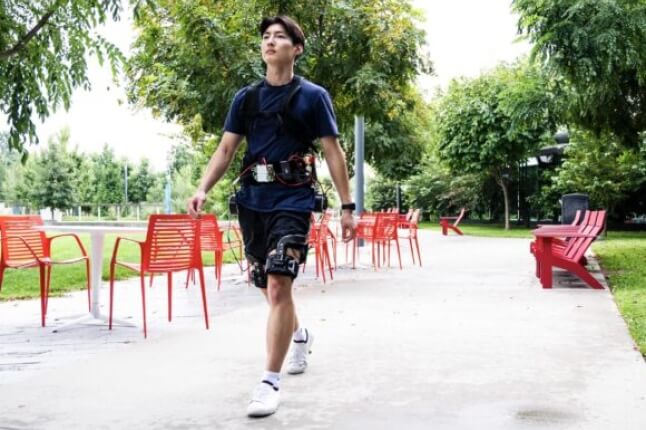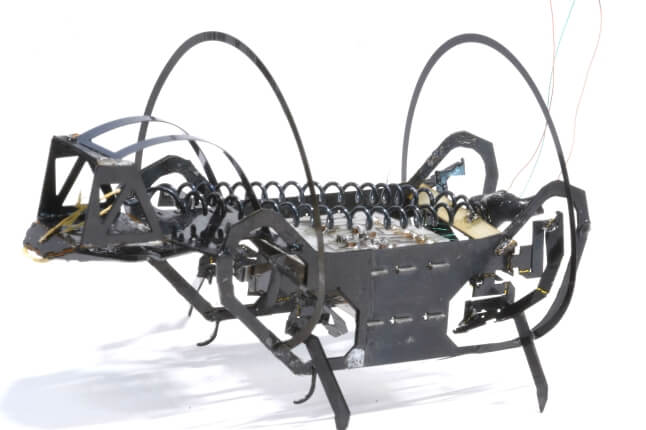News
This hopping soft robot harnesses the same physics as a toy popper. When the structure of a popper buckles, the energy released sends the toy flying through the air. Now, researchers have harnessed that energy and used buckling to their advantage to build a fast-moving, inflatable soft actuator. (Image courtesy of David Melancon and Benjamin Gorissen/Harvard SEAS)
Download ImageBuckling, the sudden loss of structural stability, is usually the stuff of engineering nightmares. Mechanical buckling means catastrophic failure for every structural system from rockets to soufflés. It’s what caused the Deepwater Horizon oil spill in 2010, among numerous other disasters.
But, as anyone who has ever played with a toy popper knows, buckling also releases a lot of energy. When the structure of a popper buckles, the energy released by the instability sends the toy flying through the air. Now, researchers from the Harvard John A. Paulson School of Engineering and Applied Sciences (SEAS) and Harvard’s Wyss Institute for Biologically Inspired Engineering have harnessed that energy and used buckling to their advantage to build a fast-moving, inflatable soft actuator.
The research is published in Science Robotics.
“Soft robots have enormous potential for a wide spectrum of applications, ranging from minimally invasive surgical tools and exoskeletons to warehouse grippers and video game add-ons,” said Benjamin Gorissen, a postdoctoral fellow at SEAS and co-first author of the paper. “But applications for today’s soft actuators are limited by their speed.”
Fluidic soft actuators tend to be slow to power up and move because they need a lot of fluid to work and the flow, whether gas or liquid, is restricted by tubes and valves in the device.
“In this work, we showed that we can harness elastic instabilities to overcome this restriction, enabling us to decouple the slow input from the output and make a fast-jumping fluidic soft actuator,” said David Melancon, a graduate student at SEAS and co-first author of the paper.
“This actuator is a building block that could be integrated into a fully soft robotic system to give soft robots that can already crawl, walk and swim the ability to jump,” said Katia Bertoldi, the William and Ami Kuan Danoff Professor of Applied Mechanics at SEAS and senior author of the study. “By incorporating our jumper into these designs, these robots could navigate safely through uncharted landscapes.”
Bertoldi is also an Associate Faculty member of the Wyss Institute.
Experimental video of three actuator designs. By tuning the pressure volume relationship between the two shells, the researchers were able to develop an actuator capable of releasing enough energy to jump, as seen in design C. (Video courtesy of David Melancon and Benjamin Gorissen/Harvard SEAS)
The researchers relied on the same type of buckling that propels toy poppers, known as shell buckling. The team designed the actuators with two spherical caps — essentially two poppers— nestled together like Russian nesting dolls and connected at the base. Upon inflation, pressure builds up between the two caps. The thinner outer cap expands up while the thicker inner cap buckles and collapses, hitting the ground and catapulting the device into the air.
While the device seems simple, understanding the fundamental physics at play was paramount to controlling and optimizing the robot’s performance. Most previous research into shell buckling studied how to avoid it but Gorissen, Melancon and the rest of the team wanted to increase the instability.
As fate would have it, one of the pioneers of shell buckling research sits just two floors down from Bertoldi’s team in Pierce Hall. Professor Emeritus John W. Hutchinson, who joined the Harvard faculty in 1964, developed some of the first theories to characterize and quantify the buckling shell structures.
“Our research shines a different perspective on some of [Hutchinson’s] theories and that enables us to apply them to a different research domain,” said Gorissen.
The actuators can be reset and brought back to the initial configuration through vacuum and can take off repetitively. (Video courtesy of David Melancon and Benjamin Gorissen/Harvard SEAS)
“It was nice to be able to get feedback from one of the pioneers in the field,” said Melancon. “He developed the theory to prevent failure and now we’re using it to trigger buckling.”
Using established theories as well as more recent numerical simulation tools, the researchers were able to characterize and tune the pressure volume relationship between the two shells to develop a soft robot capable of quickly releasing a specific amount of energy over and over again. The approach can be applied to any shape and any size. It could be used in everything from a small medical device to puncture a vein or in large exploratory robots to traverse uneven terrain.
The research was co-authored by Nikolaos Vasios and Mehdi Torbati. It was supported in part by the National Science Foundation through grants DMR-1420570 and DMR-1922321
Topics: Robotics
Cutting-edge science delivered direct to your inbox.
Join the Harvard SEAS mailing list.
Scientist Profiles
Katia Bertoldi
William and Ami Kuan Danoff Professor of Applied Mechanics
Press Contact
Leah Burrows | 617-496-1351 | lburrows@seas.harvard.edu




